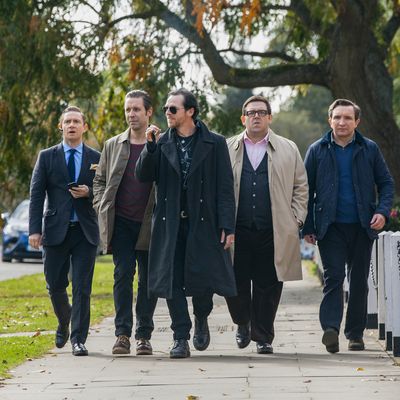
Peter Jackson may be lord of the rings and Joss Whedon may have assembled the Avengers, but in the realm of fanboy cinema, there’s no disputing the one and only true king: Edgar Wright. Over the course of a cult TV show (1999–2001’s Spaced) and four badass features — 2004’s Shaun of the Dead, 2007’s Hot Fuzz, 2010’s Scott Pilgrim vs. the World, and this past weekend’s The World’s End — Wright has crafted a canon that’s the apex of fanboydom. More than any other filmmaker working today, Wright understands not just how to market to his target audience — he’s a favorite regular at Comic-Con, and participates in frequent events at Austin, Texas’s cinephile heaven the Alamo Drafthouse — but, more important still, how to make movies that directly speak to his horror-, sci-fi-, fantasy-, gaming- and tech-obsessed demographic.
While Wright remains something of a niche figure on the global filmmaking stage (this despite his screenwriting work on Steven Spielberg’s The Adventures of Tintin), he’s beloved by those who cherish all the things that a 15-year-old — or 15-year-old at heart — likes. He’s a filmmaker who’s for the geeks because he is himself one. Here are the three primary ways that Wright rules the fanboy.
He Balances Reverence With Ridiculousness
Wright unabashedly loves the myriad tropes to which his films pay homage, but that adoration is bolstered by a tongue-in-cheek sense of humor about them. Shaun, for example, adheres to archetypal zombie lore (shuffling gait, hungry for brains, killed with head shots or decapitations) and, in its second half, mirrors the narrative trajectory of George A. Romero’s Dawn of the Dead — merely one example of Wright’s desire to both stick to time-honored formulas, as well as to allude to his many genre predecessors. Be it Hot Fuzz’s shout-outs to Bad Boys and Point Break or Scott Pilgrim’s ceaseless nods to classic games of eighties past (as with the Super Mario–esque name of Scott’s punk rock band, Sex Bob-omb), Wright’s movies love all that’s geeky, and rarely go a moment without reminding viewers of it.
Yet what actually makes his self-referential films so endearing is their eagerness to goofily mock that which they idolize. As with Don’t, Wright’s fake trailer for Quentin Tarantino and Robert Rodriguez’s Grindhouse, Wright so admires his old-school stuff (in this case, British Hammer Horror frightfests) — and is so knowledgeable about it — that his spoofery proves hilariously good-natured. Moreover, his stories’ comedy stems from a canny combination of styles, which appear disparate but wind up blending so seamlessly that they enhance each others’ strengths. Through synthesis, he finds a way to tap into all that’s wonderful and absurd — and intertwined — about zombies and rom-coms (Shaun), buddy-cop extravaganzas and small-scale regional tales (Hot Fuzz), video games and teen romance (Scott Pilgrim), and male-camaraderie odysseys and invasion-of-the-body-snatcher-style chillers (The World’s End). Like a modern-day Joe Dante, he takes his out-there material seriously while also — from an I’m-one-of-you insider perspective — recognizing and celebrating its inherent silliness.
Never Let Go of the Past
Wright’s films don’t just cite classic movies; their stories also champion nostalgia, and staying true to — and/or fighting for — the past. Just as fanboys worship things from their youth (comic books, video games, superheroes, fantasy adventures), Wright’s stories focus on holding tightly to things now lost, whether it’s Sean trying to revive a failed relationship while also maintaining his lifelong friendship with slobbish mate Ed (Frost) in Shaun, Nicholas Angel (Pegg) attempting to return to the big city and preserve his derided super-cop perfectionism in Hot Fuzz, Scott looking to woo Ramona Flowers (Mary Elizabeth Winstead) by fighting her ex-boyfriends in Scott Pilgrim, or Gary King (Pegg) reuniting with old pals to complete a pub crawl they failed to finish during high school in The World’s End.
In all these instances, Wright’s protagonists — who, in one way or another, suffer from cases of stunted maturity — triumph not by abandoning the past, but by actively clinging to it. While they all may grow wiser by film’s conclusion, Wright’s heroes don’t really grow up, or abandon those past things they so love; on the contrary, what makes them so likable is that they retain their essential man-child nature. In that respect, they’re something like the fanboy fantasy ideal — men who find success, love, and their true awesome selves by continuing to be video-game-loving, action-movie-mimicking, beer-swilling Everymen.
Hypermodernity
If Wright the storyteller is rooted in the past, Wright the director exists on the cutting edge. His filmmaking is a mix of whooshing panoramas, explosive CGI — which reaches its apex in Scott Pilgrim’s orgiastic arcade game-inspired battles — and whiplash edits, the last of which define his formal trademark of using quick three-shot montages as punchy transitional devices. Even when Wright’s movies harken back to ancestors in terms of aesthetics (such as Hot Fuzz’s duplication of the very Michael Bay tricks of the trade its characters esteem), they do so with an innovative panache that’s distinctly their own.
Amalgamating madcap special effects, exaggerated cartoon reaction shots, amusing musical cues, and sudden bursts of outrageous, expertly choreographed violence (see: The World’s End’s lucidly staged, hilariously inventive bathroom brawl) in a uniquely hyperstylized manner, his fleet work has a sensory-overloaded quality that’s attuned to a contemporary world in which media and information bombard us from every iPad-and-Internet-and-smartphone angle. That too makes him the epitome of a fanboy — continuing to find novel, ultramodern ways to channel lifelong obsessions, he’s a filmmaker who, like all good geeks, venerates the old while simultaneously embracing the new.

